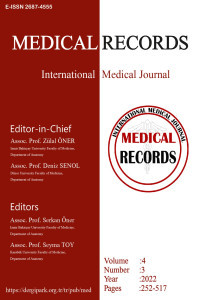Clinical and Histopathologic Efficiency of Sucralfate and Ursodeoxicolic Acid in Pediatric Duodenogastric Reflux Disease
Duodenogastrik Reflü Hastalığı, Sükralfat, Ursodeoksikolik Asit
Clinical and Histopathologic Efficiency of Sucralfate and Ursodeoxicolic Acid in Pediatric Duodenogastric Reflux Disease
Duodenogastric Reflux Disease, Sucralfate, Ursodeoxycholic Acid,
___
- 1. Zhang Y, Yang X, Gu W, et al. Histological features of the gastric mucosa in children with primary bile reflux gastritis. World J Surg Oncol. 2012;10:27.
- 2. Vaezi MF, Singh S, Richter JE. Role of acid and duodenogastric reflux in esophageal mucosal injury: a review of animal and human studies. Gastroenterology. 1995;108:1897-907.
- 3. Szarszewski A, Korzon M, Kamiñska B, et al. Duodenogastric reflux: clinical and therapeutic aspects. Arch Dis Child. 1999;81:16-20.
- 4. Hermans D, Sokal EM, Collard JM, et al. Primary duodenogastric reflux in children and adolescents. Eur J Pediatr. 2003;162:598-602.
- 5. Burden WR, Hodges RP, Hsu M, O'Leary JP. Alkaline reflux gastritis. Surg Clin North Am. 1991;71:33-44.
- 6. Dalenbäck J, Abrahamson H, Björnson E, et al. Human duodenogastric reflux, retroperistalsis, and MMC. Am J Physiol. 1998;275:R762-9.
- 7. Rosen R, Vandenplas Y, Singendonk M, et al. Pediatric gastroesophageal reflux clinical practice guidelines: joint recommendations of the north american society for pediatric gastroenterology, hepatology, and nutrition and the european society for pediatric gastroenterology, hepatology, and nutrition. Journal Of Pediatric Gastroenterology and Nutrition. 2018;66:516-54.
- 8. Stefaniwsky AB, Tint GS, Speck J, et al. Ursodeoxycholic acid treatment of bile reflux gastritis. Gastroenterology. 1985;89:1000-4.
- 9. Rosman AS. Efficacy of UDCA in treating bile reflux gastritis. Gastroenterology. 1987;92:269.
- 10. Neyzi O, Bundak R, Gökçay G, et al. Reference Values for Weight, Height, Head Circumference, and Body Mass Index in Turkish Children. J Clin Res Pediatr Endocrinol. 2015;7:280-93.
- 11. Dixon MF, Genta RM, Yardley JH, et al. Classification and grading of gastritis. The updated Sydney System. International Workshop on the Histopathology of Gastritis, Houston 1994. Am J Surg Pathol. 1996;20:1161-81.
- 12. Kahrilas PJ, Shaheen NJ, Vaezi MF. American Gastroenterological Association Institute technical review on the management of gastroesophageal reflux disease. Gastroenterology. 2008;135:1392-1413, 413.e1-5.
- 13. Castell DO, Kahrilas PJ, Richter JE, et al. Esomeprazole (40 mg) compared with lansoprazole (30 mg) in the treatment of erosive esophagitis. Am J Gastroenterol. 2002;97:575-83.
- 14. Spechler SJ, Sharma P, Souza RF, et al. American Gastroenterological Association technical review on the management of Barrett's esophagus. Gastroenterology. 2011;140:e18-52; quiz e13.
- 15. Souza RF. From Reflux Esophagitis to Esophageal Adenocarcinoma. Dig Dis. 2016;34:483-90.
- 16. Nehra D, Howell P, Williams CP, et al. Toxic bile acids in gastro-oesophageal reflux disease: influence of gastric acidity. Gut. 1999;44:598-602.
- 17. Peng S, Huo X, Rezaei D, et al. In Barrett's esophagus patients and Barrett's cell lines, ursodeoxycholic acid increases antioxidant expression and prevents DNA damage by bile acids. Am J Physiol Gastrointest Liver Physiol. 2014;307:G129-39.
- 18. Singh S, Khanna S, Pardi DS, et al. Effect of ursodeoxycholic acid use on the risk of colorectal neoplasia in patients with primary sclerosing cholangitis and inflammatory bowel disease: a systematic review and meta-analysis. Inflamm Bowel Dis. 2013;19:1631-8.
- 19. Chen TF, Yadav PK, Wu RJ, et al. Comparative evaluation of intragastric bile acids and hepatobiliary scintigraphy in the diagnosis of duodenogastric reflux. World J Gastroenterol. 2013;19:2187-96.
- 20. Mittal BR, Ibrarullah M, Agarwal DK, et al. Comparative evaluation of scintigraphy and upper gastrointestinal tract endoscopy for detection of duodenogastric reflux. Ann Nucl Med. 1994;8:183-6.
- 21. Camacho-Gomez SM, Bernieh A, Saad AG, et al. Non-Helicobacter pylori Gastric Intestinal Metaplasia in Children: A Series of Cases and Review of the Literature. Case Rep Gastrointest Med. 2018;2018:5930415.
- 22. Riddell RH. Pathobiology of Helicobacter pylori infection in children. Can J Gastroenterol. 1999;13:599-603.
- 23. Oderda G, Vaira D, Holton J. Age-related increase of Helicobacter pylori frequency in symptom-free and in dyspeptic children. Lancet. 1992;340:671-2.
- 24. Wu TC, Chen LK, Hwang SJ. Seroprevalence of Helicobacter pylori in school-aged Chinese in Taipei City and relationship between ABO blood groups. World J Gastroenterol. 2003;9:1752-5.
- Yayın Aralığı: Yılda 3 Sayı
- Başlangıç: 2019
- Yayıncı: Zülal ÖNER
Abdulmecit AFŞİN, Kasım TURGUT, Nurbanu BURSA, Erdal YAVUZ, Taner GÜVEN, Yusuf HOŞOĞLU
Cemil ÇOLAK, Ahmet Kadir ARSLAN, Hasan UCUZAL, Adem KÖSE, İsmail Okan YILDIRIM, Emek GÜLDOĞAN, Mehmet Cengiz ÇOLAK
Adult Onset Langerhans Cell Histiocytosis: A Single Center Experience
Serhat ÇELİK, Zeynep Tuğba GÜVEN, Onur AŞIK, Muzaffer KEKLİK, Leylagül KAYNAR, Bülent ESER, Mustafa ÇETİN, Ali ÜNAL
Identification of Neutrophil/Lymphocyte Ratio as a Unique Biomarker for Migraine Follow-up
Elif UYGUR KUCUKSEYMEN, Gızem AKCA
Hakan SOYLU, Betül ÜNAL, Kubra AKSU ISTIL, Kayihan KARACOR, Özge BEYAZÇİÇEK, İsmail ÜSTÜNEL
Surgical Fixation with Cannulated Screws in the Adult Femoral Neck Fractures
İsmail GÜZEL, Oktay BELHAN, Tarık ALTUNKILIÇ
Orhan GÜVENÇ, Mesut ENGİN, Senol YAVUZ
Cerrahi Rezeksiyon Gerektiren Transvers Kolon Yerleşimli Pnömatozis Sistoides İntestinalis Olgusu
Olcay ÖZDEMİR, Yağız ÖZBAY, Neslihan YILMAZ ÇIRAKOĞLU
CRP and LDH Levels Can Be Used for Support the COVID-19 Diagnose in Intensive Care Unit Patients
Önder OTLU, Zeynep EKER KURT, Feyza İNCEOĞLU, Ulku KARAMAN, Tuğba Raika KIRAN
